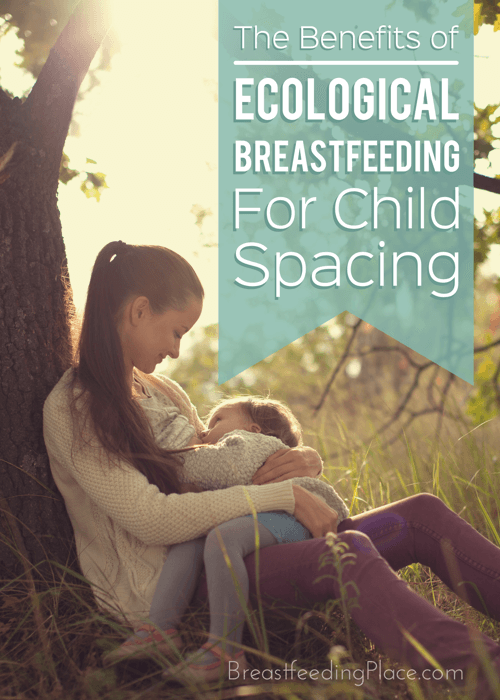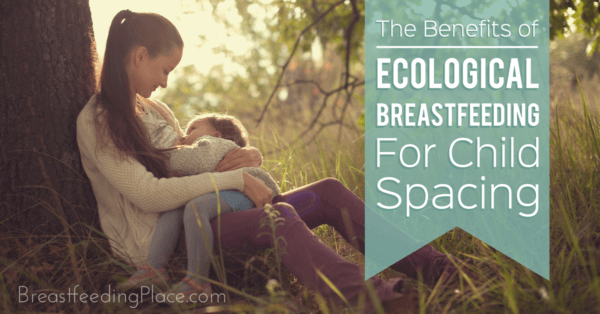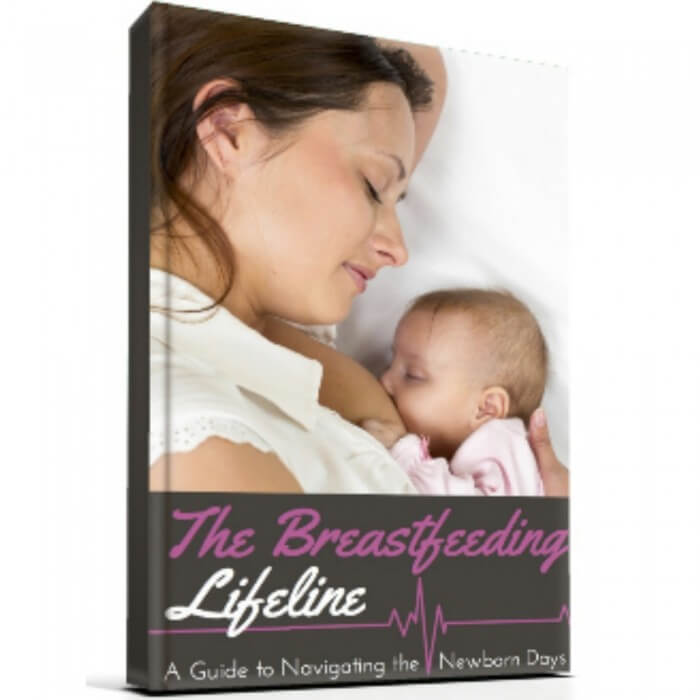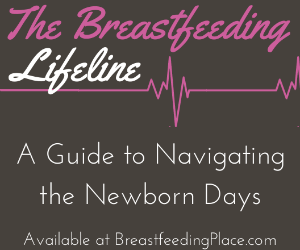Conception and child spacing are frustrations for nearly every woman I know. It doesn’t matter where they are in their journey toward (or away from) motherhood. I’m so thankful that coming across the idea of “ecological breastfeeding” a decade ago dispelled some of the anxiety of my childbearing years!

When I became fed up with hormonal contraceptives and decided to track my cycles and use Fertility Awareness instead, my brain immediately calculated for the most extreme scenario.
Roughly 24 years of fertility left, with a baby born every two years = 12 BABIES! Oh my!
That’s assuming I had no multiples, miscarriages, or children born closer together. I knew nothing yet about how fertile we as a couple were. But, the potentially humongous family looming in our future was a little daunting.
I am the type to research everything to death. In this case my research assuaged some of my fears and (thankfully!) helped me form a strategic plan. (As a side note, working through the potential of a dozen children also allowed me to assess my attitude toward children and become comfortable with that idea if that’s how life worked out. Both the planning and the acceptance have been equally beneficial.)
A large part of that plan banked on being able to use breastfeeding to extend my postpartum infertility.
Most breastfeeding women experience an average of 6 months amenorrhea after a baby is born and initial bleeding has stopped. The actual range (rather than the average) of time for a woman’s menstrual cycle to return is between a few weeks and a few years, though!
The World Health Organization lists the Lactational Amenorrhea Method of contraception (exclusively breastfeeding for the first 6 months – effective as long as bleeding doesn’t return) as an acceptable option for new mothers, but I wanted to know how to get into that group of moms who experience longer absence of menstruation and fertility!
Before I get into the specifics of what I learned to call Ecological Breastfeeding, I want to take a moment to say loud and clear that there’s no RIGHT way to breastfeed.
My goal in sharing this information is not to set a moral standard for you to try and meet. Every family has different breastfeeding needs, and every kind of breastfeeding has wonderful benefits. If you are interested in learning how to increase the length of infertile time breastfeeding gifts you, read on. However, know that these guidelines will help but are not a test of good mothering!
Ecological Breastfeeding and Natural Child Spacing
I read every book and article I could get my hands on to find out how likely I was to get pregnant while breastfeeding. I was THRILLED to find the works of Sheila Kippley, a Catholic mother and founder of the Couple to Couple League (you can now find her at Natural Family Planning Intl). Because Catholic theology disapproves of contraceptive use, Sheila has spent decades advocating for an understanding of how the reproductive system works and how breastfeeding affects it.
Her book Breastfeeding and Natural Child Spacing was exactly what I was looking for! It’s a little bit long, but so fascinating! She’s also written a more concise book called The Seven Standards of Ecological Breastfeeding: The Frequency Factor that you may prefer.
She coined the term Ecological Breastfeeding. In her book, she explained that women who practice Ecological Breastfeeding experience an average of 14.6 months of delayed fertility (lactational amenorrhea).
That’s more like it!
The difference between “exclusive” breastfeeding and “ecological” breastfeeding can be explained with seven “standards” that she covers in much more detail. I like to think of these as having little check-boxes. The more of them I can cross off, the longer my fertility will be suppressed.
Meeting any of these standards is likely to delay your period longer than not meeting them. Meeting all of them will give you the maximum spacing that your body will naturally allow between pregnancies without other health issues or contraceptives factoring in.
Please do get a copy of her book if you are interested. She goes into great detail about all of the nuances of the practices that affect our fertility. Consider this an introduction.
In my own words, here are the “Seven Standards of Ecological Breastfeeding”:
1. Breastfeed exclusively – This means not offering any other foods or liquids before 6 months.
2. Comfort nurse – Do not limit breastfeeding sessions to only meal times or restrict access for comfort.
3. No bottles or pacifiers – Nipple stimulation has a huge effect on hormones. Pacifiers decrease time spent at the breast, and pumping doesn’t provide the same amount of stimulation.
4. Co-sleep – Babies who sleep with mom nurse much more frequently at night, which is essential for delaying fertility.
5. Lie down with baby for a daily nap feeding – Increased rest will help maintain milk supply, and baby is likely to stay at breast longer with you near.
6. Nurse on demand and often – Avoid schedules and instead follow baby’s cues to ensure frequent breastfeeding.
7. Stay close to baby – Avoid anything that separates you from baby for any length of time, such as returning to work.
There are definitely always going to be anomalies. I have a girlfriend who follows almost all of these standards and still had 5 children in 7 years. And there are parts of the world – like rural Central Africa – where the average is much longer than even the numbers Sheila reports.
Ecological Breastfeeding offers many benefits to mother and baby – physically and emotionally. The subsequent side-effects are huge bonuses and delayed fertility is a reality for the vast majority of women who follow all seven standards.
When you hear people say that breastfeeding didn’t delay their fertility, know that they could be the outliers. However, keep in mind that very few people adhere to all seven of these standards. Not everyone is able or willing to do them all. Because every family’s needs are different, it would be wrong to state that following the seven standards is the optimal way to breastfeed for every family. However, Sheila Kippley and those who have followed her advice felt strongly about the benefits of considering this lifestyle.
My own experience has been a lengthened return of fertility and child spacing. I have four children, and my cycles returned at 10, 18, 12, and 9 months respectively. The space between my babies has been 25 months, 28 months, and 33 months. I can look at these standards and easily see how not keeping some of them affected those numbers. (I pumped more with my fourth baby, for instance.)
What about you? Are you familiar with ecological breastfeeding? If you’ve used it, has your experience lined up with that 14.6 month average?







My period just returned last month 28 months postpartum! I followed all 7 standards with both my children, and they are spaced 3 years apart (they had the same due date….but my first was late and the 2nd was early). My first was nursed for 26 months and stopped on his own when I told him it was hurting me, my 2nd is still comfort nursing, nap nursing, and we co-sleep so she nurses throughout the night. I’m ready to be done, but she doesn’t want to give it up! However, we are done having babies, so when I had a c-section with my 2nd I had my tubes tied, there were too many complications with the last pregnancy and I’m hitting my mid-40’s (eeek!). It’s fascinating how God built our bodies!
After my first, my cycle returned after 22 months, after my second (who actually nursed much less than my first) it took 25 months, after my third son, my cycle returned in month 24. It will be interesting to see when my cycle returns after number 4 (who is due in the spring). Ecological breastfeeding had led to 4 children in 9 year, my eldest will be 9 a couple weeks after this baby comes. I have found that body shape/size can sometimes (though not always) have an effect. Both through research as well as personal experience, less weight can lead to longer non-fertile times.
I could be the poster child for natural family planning/child spacing, but in my case, it worked a little too well.
I nursed my first until she was almost 26 months. I nursed on demand and at night, with her not sleeping in a crib until she was nearly two. I did return to work three days per week when she was nine months old, but I continued pumping at work until she was 22 months. I introduced solids before she was six months, due to her failure to gain sufficient weight. I also used a nipple shield until she was nearly one (flat nipples). She didn’t use a pacifier but did drink from bottles when I was at work. My cycle returned when she was nearly 18 months. I got pregnant with my second four months after weaning her, but we relied on condoms as birth control once my cycle returned, and got pregnant immediately.
My son was born when she was 39 months, and I was able to be home full-time with them both. He spent twelve days in the NICU, during which I pumped and mostly bottle fed him EBM (the nurses at the time discouraged nursing directly because he needed the bilirubin lights). After that, he was exclusively breastfed until he was at least eight months, with solids not a consistent part of his diet until he was nearly one. I did a lot of baby wearing (he was enormous–gained a pound per week for the first three months and barely afford down after that–and didn’t walk until nineteen months) and he didn’t sleep in a crib until he was nineteen months (and even then he didn’t stay there through the night). I started night weaning to encourage my cycle to return, but it didn’t until he was 22 months. I was able to get pregnant two months later. I’m 2.5 weeks away from delivering and still nurse my son, but limit it (usually) to a long session before bed and when he wakes up.
I think I am very sensitive to hormones, though, so it didn’t take much for my body to respond. With my next, I plan to night wean earlier so that I can have my children a little closer, hopefully (#3 will be 2 years and 9 months younger).
I am sure that Sheila would appreciate your linking to NFP International, and not CCL, where she now blogs : http://www.nfpandmore.org She is no longer associated with CCL anymore as the Board there made changes away from ecological breastfeeding! So she and John still do what they used to do using “NFP: The Complete Approach” book — you can read about it at the archived blogs plus see all kinds of neat links – Thanks
edited to add. Thanks.
I have been following these without knowing anything about ecological breastfeeding. My son is 18 months and still nursing. Never used bottles or pacifiers. Co sleeps with me from day one. And nurses when he wants. . I still have not got my menstral period . I did the same with my two younger kids and they are 23 months apart. How cool I can’t believe I never seen anything about ecological breastfeeding. It’s true for me everything you said. Thanks for sharing this.